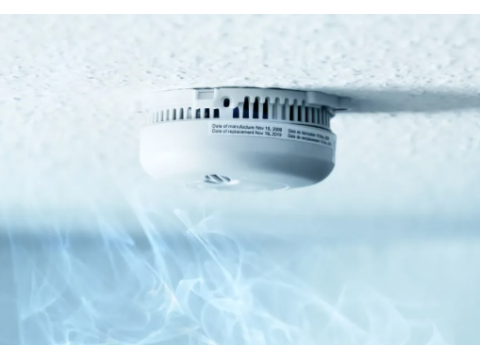Fire alarm detectors (often called fire sensors) are essential devices that detect signs of a potential fire—such as smoke, elevated temperatures, or open flames—and convert these indicators into electrical alarm signals. Depending on the environment and the principal fire risk factors, different types of detectors (smoke vs. heat vs. flame) may be used. Below, we focus on smoke and heat detectors in both wired and wireless configurations, describing how each detects fire conditions and relays that information to a fire alarm control panel or as a standalone alert.
Universal Principles of Fire Alarm Detectors
Despite the variety of sensor types, all fire detectors share these key tasks:
Detect Fire Factors
- Smoke (aerosol particles in the air)
- Temperature Changes (rising ambient heat)
- Flame (visible UV/IR radiation)
- (Some specialized detectors measure combustion gases, like carbon monoxide)
Generate & Transmit an Electrical Signal
- The detector outputs a state change or digital message when thresholds are met.
- Signals might be “open/close” relay outputs (in simpler detectors) or more complex digital data in addressable systems.
Point vs. Linear Detection
- Point (Spot) Detectors: Sense fire conditions (smoke or heat) at the location of the sensor.
- Linear Detectors: Monitor an extended distance (e.g., a beam or cable) for smoke attenuation or temperature rise along a length of space.
Smoke Detectors: Operation Basics
Smoke detectors commonly rely on:
Ionization
- A small radioactive source ionizes air between two electrodes.
- When smoke enters, it alters the ion flow and triggers an alarm.
- Less used nowadays, but effective for fast-flaming fires.
Optical (Photoelectric)
- Infrared emitter and photodiode in a “labyrinth” or chamber.
- In normal conditions, the IR beam does not reach the diode directly.
- Smoke particles scatter the IR light toward the receiver, causing an alarm if sufficiently intense.
Spot vs. Linear Smoke Detectors
- Spot Detectors (Point)
- Typically ceiling-mounted and measure smoke density at the detector location.
- Use the optical scattering or ionization method.
- Linear (Beam) Detectors
- IR transmitter and receiver (or a single module plus reflector) across a large space.
- Smoke attenuates the beam, and if it drops below a threshold, the detector alarms.
- Suitable for wide areas (warehouses, atriums).
Aspirating Smoke Detectors
- Principle: A small pump or fan draws air samples from multiple points in a room via tubing.
- Analysis: An onboard high-sensitivity sensor examines these samples for smoke.
- Benefit: Early warning—detects even minimal smoke concentrations.
Heat Detectors: Operation Basics
Heat detectors measure temperature at their location (point detectors) or along a cable (linear detectors). Common heat-detection methods:
Maximum (Fixed)
- Activates at a preset temperature (e.g., 135–160°F).
- Can be one-time fusible links or resettable designs with built-in sensors.
Differential (Rate-of-Rise)
- Reacts to a rapid temperature increase.
- If the room heats slowly, no alarm is triggered.
Combination (Max-Differential)
- Merges both “fixed” and “rate-of-rise” to catch different fire scenarios more reliably.
Linear Heat Detectors
- Cable-Based:
- An electrical or electromechanical cable runs through a space, changing resistance or shorting under heat.
- Ideal for long corridors, tunnels, cable trays, or elevator shafts.
- Tubes or Pneumatic:
- Sealed tubes with gas that expands under heat, monitored by a pressure sensor.
- Triggers an alarm if pressure rises beyond a threshold.
Signal Formation & Transmission
All fire detectors must convert the fire factor (smoke or heat) into an alarm signal—wired or wireless. Common output methods:
Mechanical Contacts (“Dry” Contacts)
- A simple open/close relay.
- Frequent in maximum heat detectors and certain line-based thermocables.
- Works with most conventional fire alarm panels.
Electronic Key (Current-Based)
- Many spot smoke or max-diff heat detectors have onboard circuitry that changes internal resistance or draws higher current when triggered.
- The panel sees increased current in the loop, signifying alarm.
Digital (Addressable)
- Detector transmits digital data with a unique address.
- The control panel discerns which device triggered, potentially receiving more data (e.g., sensor health, real-time values).
Wired vs. Wireless Systems
- Wired:
- Continuous loop supervision; immediate panel awareness of loop faults (open/short).
- Typically less expensive hardware, but higher labor costs for cabling.
- Wireless:
- Radio-based signals from each detector, each powered by batteries.
- Periodic polling instead of continuous loop monitoring.
- Great for retrofits or aesthetically sensitive areas but costlier per device.
Practical Differences: Wired & Wireless
Wired:
- More robust line supervision, no battery maintenance.
- Can group multiple detectors on a single circuit.
- Performance unaffected by radio interference; cables must be carefully run and protected.
Wireless:
- Quick installation, minimal disruption to walls or ceilings.
- Each sensor has a built-in transmitter and battery.
- Some systems offer full addressability and digital status, but rely on consistent radio coverage and battery checks.
Putting It All Together
Fire detectors—whether smoke or heat, wired or wireless—detect physical changes correlated to fires (smoke density, heat thresholds) and signal an alarm. The simplest sensors rely on mechanical contact changes or increased current draw in a loop (threshold approach). More advanced (addressable) detectors digitally communicate data to the control panel, offering precise location IDs and real-time parameters.
What’s crucial is matching the detector type to the environment:
- Smoke sensors: General use, but watch for dust or steam.
- Heat sensors: Best in dusty or steamy areas, but slower to detect smoldering fires.
- Wired detectors**: Great for new constructions or large-scale systems with robust cabling.
- Wireless detectors**: Ideal for difficult retrofits or architectural constraints, but must manage battery upkeep.
Conclusion: Understanding the fundamental principles behind these detectors enables better design, minimizing false alarms and optimizing early fire detection. For more guidance on selecting and installing smoke or heat fire sensors—wired or wireless—visit safsale.com. Our specialists can tailor a fire alarm solution to your specific building layout, risk factors, and code requirements.

